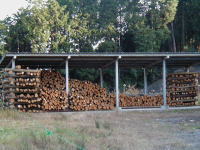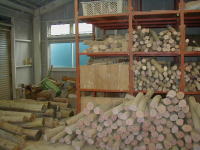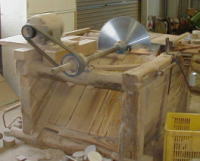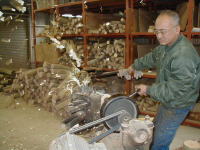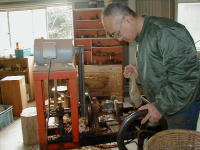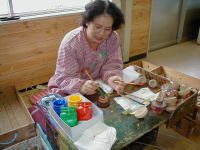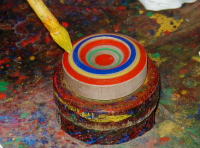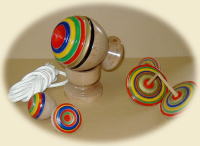| #22 January
2002 |
 This page is written monthly by Harumi Okochi, and sometimes Harumi's friends join. We'd be happy if you look at our previous issues. #1 GREETING |
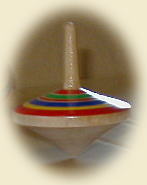 |
||||||
New Year's Joy for Boys ―Japanese Tops― |
||||||||||||||||
| Hello, friends. I hope you are all safe and well and calm in the beginning of 2002. Today, I'd like to tell you about the "tops" made here in Karatsu. I have heard that there are varieties of tops in every place of the world. The shapes, colors, playing rules, must differ, but the idea is same both in the East and the West. What a happy coincidence it is! In Japan, a top is a boy's toy in new year time. How I envied my brother who was happy with a n 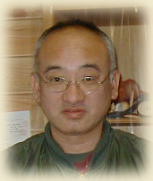 ew top on the morning of the new year day! ew top on the morning of the new year day!A top is called "Koma" in Japanese. It is said that the history of Koma in Japan is very old. It came from China through Korean Peninsula where there was a country Japanese people called "Koma" at that time. Isn't that fascinating? A toy that came to us from far way and from long ago. Well, I will introduce 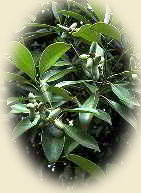 you Mr. Koichi Kumamoto, the third generation
of Koma making in Karatsu. you Mr. Koichi Kumamoto, the third generation
of Koma making in Karatsu.Koichi's grandfather Yoshitaro came to Karatsu from Yanagawa, Fukuoka Prefecture, and settled down here because of the abundance of the material beechwood. Yoshitaro's son Hidetoshi also made Komas, but he died when Koichi was 16. Hidetoshi's wife Saeko tried her best to support the family becoming a Koma craftsman herself. She made beautiful Komas. Then Koichi succeeded and the mother and the son together made Komas. Saeko passed away last year. We visited Koichi's new studio in the mountain side of Karatsu. He welcomed us so warmly and let us take pictures while he was working.
Spinning, first waving unsteadily, then gradually settling and sleeping, it becomes most still. When the top sleeps, I always make a wish to let it turn forever. At the beginning of this year, I will wish upon a Koma, "Let the world be turning still!" Thank you very much for having visited my web-site. I really hope I can see you again sometime. Yours, Harumi Okochi |
||||||||||||||||
|
|
||||||||||||||||
|
|
